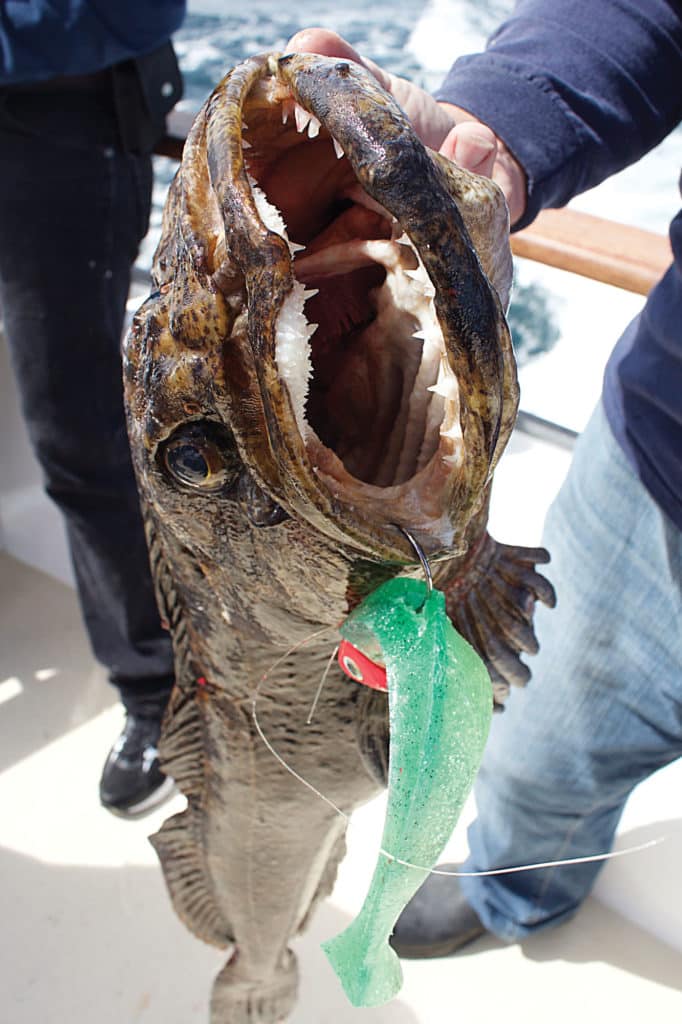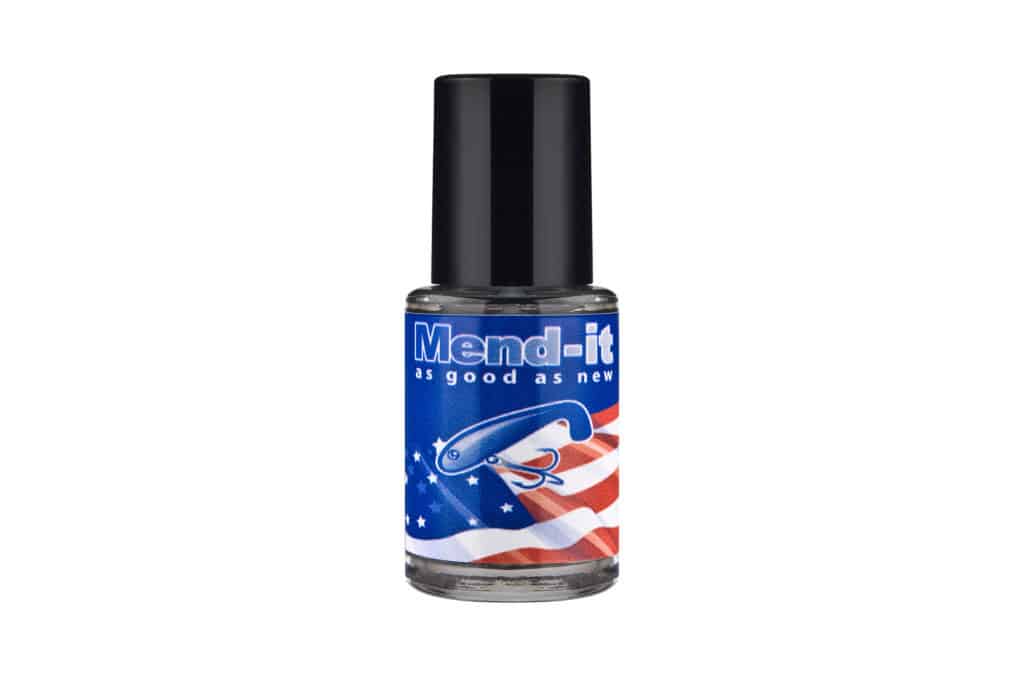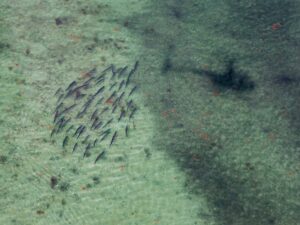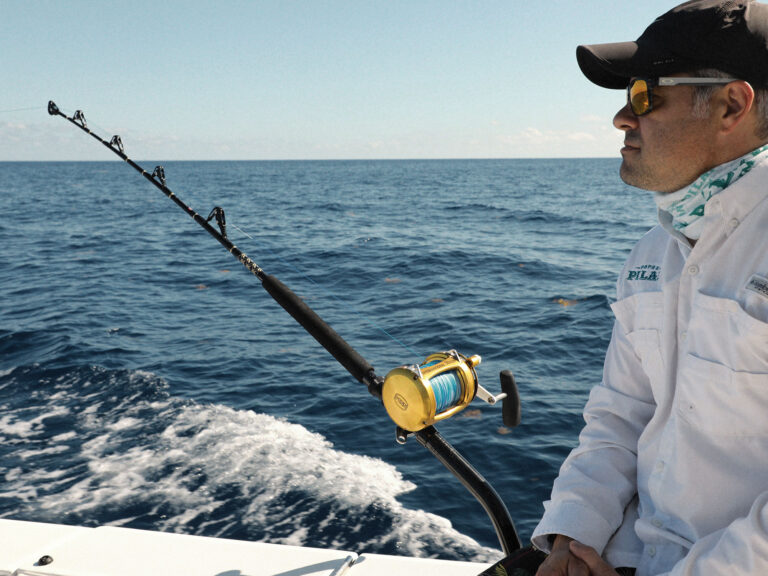
Lingcod rule the rock piles of Southern California’s coastal waters endowed with cavernous mouths studded with teeth, they’re eager to latch on to whatever swims by. Whether they can swallow what they attack seems irrelevant. They often grab other fish as they’re reeled in and refuse to let go, holding on all the way to a waiting net or gaff. This trait might not be sophisticated, but it makes lingcod ideal targets for oversize reaction baits when lingcod fishing.
California-based tackle manufacturers like Kustom Kraft, Candy Bar and Okuma have developed a variety of supersize lingcod swimbaits that take advantage of the lingcod’s fatal attraction to more-than-a-mouthful meals. With thick-bodied, sturdy plastic tails up to 9 inches long, heavy wedge-shaped lead-heads and 7/0 to 10/0 hooks, these lures capitalize on the lingcod’s ravenous appetite. Okuma’s FishLab lures offer a heavy-duty swimbait called the Mack Attack Soft Swimbait.
And it didn’t take long for local fishermen to discover just how effective — and flat-out fun — these mega lingcod lures can be for catching the biggest, meanest lingcod on the reef. While California lingcod generally aren’t as large as the alligator-size models caught in Alaska, fish commonly range from respectable 22-inch “legals” to trophy specimens of 25 or 30 pounds.
Fish Deepwater for Lingcod

Depending on the location and the time of year, lingcod can be caught over high-relief rocky structure in depths from 75 to more than 300 feet. Lingcod fishing from a drifting boat over a large hard-bottom area when the wind is up and the current is running adds to the challenge of making an effective presentation.
Swim the big lingcod lures as close to the bottom as possible, and keep it in that zone as long as you can. When fishing on a party boat, it’s best to throw these lures from the bow or the downwind corner of the stern. This lets you cast as far as possible down-drift without interfering with other anglers who are fishing traditional dropper-loop rigs.
Sink the lure as quickly as possible, and when you hit bottom, work the swimbait with a medium-slow retrieve for about 15 turns of the handle. If you don’t get bitten, free-spool back to the bottom and start again. As the boat drifts over and eventually away from your line, you’ll need to recast and start again.
How to Hook a Lingcod with a Swimbait

If all this seems too complicated, here’s some good news: It seldom takes long to get slammed once you get your swimbait in the zone. In addition to drawing big lingcod like a magnet, these lures often catch the biggest vermilion and copper rockfish.
It takes practice and discipline to get the knack of hooking lings on these big baits. The key is to keep grinding into the fish until the rod is fully loaded. Picture the lingcod latching on to the plastic tail “hitchhiker” style and munching its way toward the hook. As long as you keep reeling, the fish is going to think the lure is a meal trying to get away — and that’s something this apex reef predator won’t stand for. Even if a hooked ling comes unbuttoned on the way up, they often attack the lure again, as long as it’s moving.
When you hook a big ling, they usually make an initial strong run back toward the bottom. It’s important to tighten down the drag right away and get the fish headed in your direction. Once you move a fish off the bottom, just keep steadily grinding toward the surface without pumping the rod. When you do this, lingcod seem to come up almost willingly, but this often changes when they see the surface. Another reason for the slow and steady approach is that repeatedly lifting and dropping the rod tip causes the heavy lead-head to work loose from the fish’s jaw. Unlike rockfish, lingcod don’t suffer from the effects of barotrauma, regardless of how deep they’re hooked, so they often go crazy next to the boat.
Fish Heavier Bigger Saltwater Swimbaits in Deeper Water

Boats like Pacific Dawn, with Ventura Sportfishing, began popularizing this technique on trips to Santa Rosa and San Miguel in the outer Channel Islands, the mecca of Southern California lingcod fishing. Here, when conditions are right, you can fish these giant swimbaits in depths of 100 feet or less, rigging the plastics on 4-ounce jig heads. Plenty of local makers produce swimbait bodies, but so do national manufacturers such as No Live Bait Needed 5- and 8-inch paddle tails.
I remember one sunny afternoon when I could see all the way to the bottom, and I watched a formation of three lings as long as my leg tracking my swimbait before one of them darted out and attacked. I was instantly hooked on this method, and if I’m on a rockfish trip today, I’m tossing swimbaits to the exclusion of everything else.
As water depth increases or the drift gets faster, it takes a little more work. Still, I’ve caught plenty of lings this way in 300 feet or more, by moving up to heavier heads and adjusting my technique to a more vertical, up-and-down swimming action. A 6-ounce lead-head is a good all-around choice, and when conditions warrant, an 8-ounce head gets you down quicker and keeps you near the bottom longer. When even heavier weights are needed, try pre-rigged options with contoured lead-heads weighing 9½ or 16 ounces. These are big saltwater swimbaits, with tails like those from Big Hammer.
Rigs for Lingcod Fishing

Lingcod lures come in a variety of colors, from glow-in-the-dark to natural baitfish colors to patterns that mimic the rockfish that live in the same deep structure. Different swimbait aficionados will swear by their own favorites, but I haven’t found color to make much difference.
The quick-sinking, zero-stretch characteristics of braided line let you work these lingcod swimbaits on light tackle. An 8- or 8½-foot jig stick paired with a conventional reel spooled with 65-pound braid does the job. My go-to rig is an 8-foot, extra-fast-action jig rod rated for 50-pound line. It’s important to use only a few feet of 30- or 40-pound monofilament between the braid and large saltwater swimbait. This maximizes sink rate and provides shock absorption when a big ling goes nuts next to the boat.
This technique might have started around the Channel Islands, but it works on lingcod everywhere: northern California, in the Pacific Northwest and in Alaska, always with the same result. When I first pull one of these lures out of my tackle box and tie it on, everybody looks at me like I’m crazy. After I put a few big lingcod on the deck, they inevitably ask if they can try some of my jumbo swimbaits for themselves.
California Lingcod Tackle

- Rods: 8- to 8½-foot fast-action 50-pound jig rods
- Reels: Lever-drag reels from your favorite brand
- Line: 50- to 65-pound braid with a few feet of 30- or 40-pound mono leader
- Lures: Kustom Kraft or Candy Bar swimbaits on 4- to 8-ounce wedge-shaped lead-heads; Savage Gear Herring swimbaits in 9½- or 16-ounce sizes










